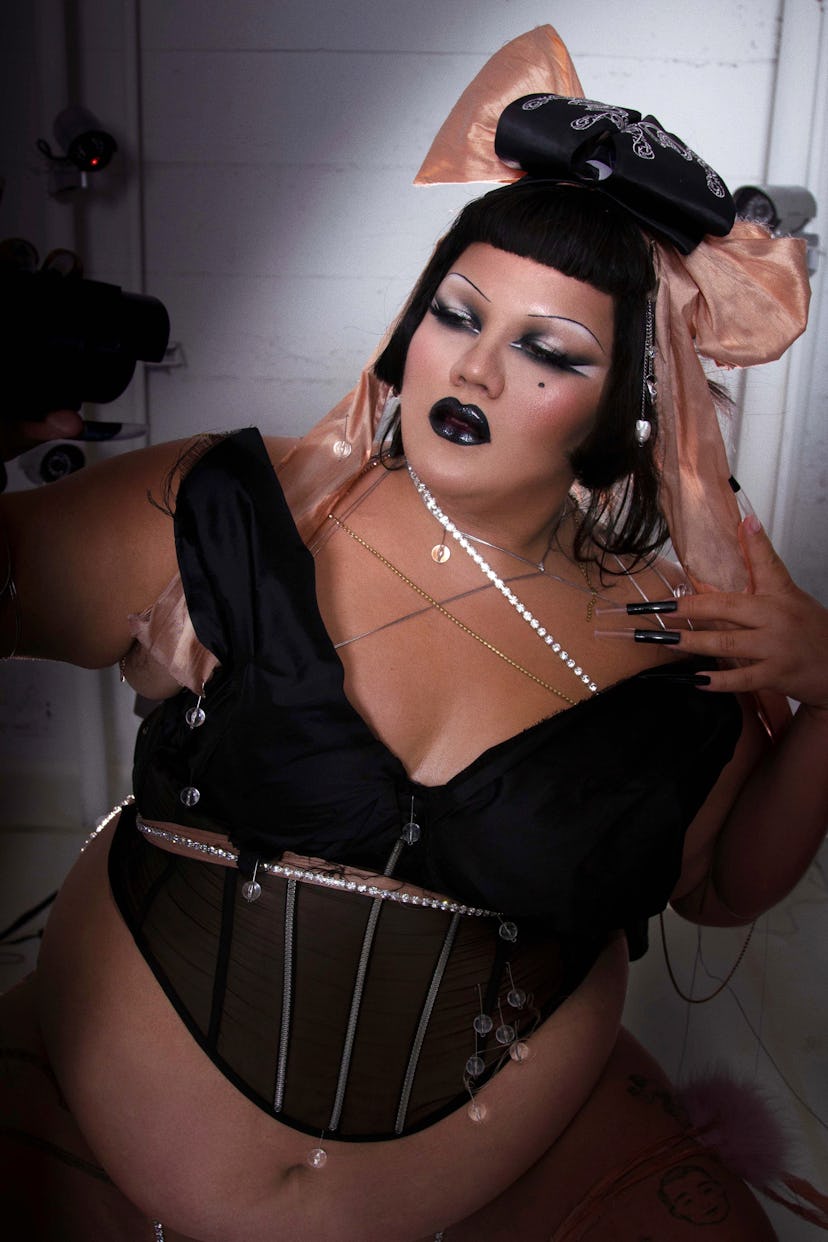Watch your step as you enter artist Gabriela Ruiz’s mind—a hypnotic hall of mirrors that defies the limits of gallery space and rips you through a labyrinth of neon paths, digital dead ends, and sensory overload. You might accidentally slam into some Plexiglas if you’re not careful. But isn’t art best when it hits you in the face?
“Once in a while you’ll hear a big thump and know someone ran into a wall,” one museum staffer says at the entrance of Stream (mixed media, 2022), Ruiz’s immersive exhibition at the Palm Springs Art Museum, on view now through January 29. “I’ve come to this museum since I was a child,” another staffer says. “I’ve never seen anything like this.”
Stream is a deeply layered, life-size maze containing dozens of see-through panels, distorted mirrors, video surveillance, blue sand, found objects, 3D self-portraits, fast-cut micro-montages, spatial audio, and more. It’s a journey through the anxious and thrilling insides of an artist who found comfort as a child in carnivals and haunted houses.
“I would enter these temporary worlds built overnight in empty parking lots and was overcome with the fantasy,” says Ruiz during a walkthrough of her exhibit. “These spaces were scary and disorienting to other kids, but to me, they felt familiar because I could relate to the chaos.”
The mirror maze re-imagines an upbringing and identity caught in-between spaces, as if to say, “try and put me in a box and this is the kind of box you’re going to get.” Her mission is not to solve the maze, but to inhabit it—and take up as much real estate as possible.
“A lot of my work talks about finding a home in things,” she says. “I want to champion the voice of myself and others like me while carving out space in worlds where they are seen as outsiders. Coming from an immigrant household, the search for home is something very personal to me.”
Ruiz was raised by Mexican émigrés in the San Fernando Valley. She clawed her way into the art world without formal education or training only five years ago, and parlayed set design gigs, as well as jobs in the queer nightlife scene, into a reputation for audacious performance-stunts and hyper-surreal installations. In one piece, she's bathing herself in the nude on a bed of laundry soap in Antwerp; in another, she's throwing fluorescent paint and insulation foam all over a multiroom complex.
Inside Gabriela Ruiz’s Palm Springs Art Museum exhibition.
“Her work speaks to this next generation of artists who are looking for authenticity in their work, who really don't see a distinction between who they are and what their art is,” says Adam Lerner, Palm Springs Art Museum’s executive director and CEO. “It's so clearly coming from deep inside her, that it expresses itself in her clothing, in her performance, in her physical art.”
She’s exhibited at museums and galleries across the globe, but it was her debut solo show at Vincent Price Art Museum that led the L.A. Times to anoint Ruiz "the breakout art star" of 2021.
“She's not making art with an ironic distance, or an intellectual lens on the world,” Lerner says.
Although her work often calls out questions of self and community, Ruiz is weary of labels like “Latinx,” “queer,” “body-positive,” terms she identifies with, but doesn’t want to be defined by, or commodified to fit a certain narrative.
“You can tell from my name that I’m not a white artist,” Ruiz says. “I know who I am, and I want the art to speak for itself. And one thing about me: I’m gonna make it work,” she says. She holds a fierce allegiance to YouTube University and thrifting and credits her parents, who run a handiwork business, with this do-it-yourself tenacity (along with her carpentry and fabrication skills). It’s a work ethic also rooted in Mexican traditions, where art is often made from scavenged and upcycled detritus. Not quite kitsch, assemblage, or arte povera, she says, but more accurately rasquachismo, an underdog mentality and Chicano aesthetic that "makes the most from the least.”
Stream marks an architectural and technological milestone for Ruiz, especially since the set was designed, built, and installed during her month-long stint as the museum’s artist in residency. The program gives her carte blanche to experiment and showcase anything. She also got to choose another artist to show alongside her. Instead of one person, she selected four: Maria Maea, Ruben Ulises Rodriguez Montoya, Karla Ekatherine Canseco, and Clara Nieblas.
Two totems greet you at the entrance of Streams: one is a rendered animation of a Ruiz-like ouroboros revolving in space; the other is a scorpion the artist found in a neighboring desert. Inside, sounds and videos from Ruiz’s phone are transformed into soundscapes by Andrew “011668” Eastman and visuals by Derek Holguin—it becomes her memory palace, media that will outlive her, for posterity or archivists, or aliens. Thanks to spatial audio by Emmett Palaima, the Plexiglas pulsates until you reach the coda to the mirror maze: Ruiz’s decapitated body made of a plastic filament. The artist cast her body neck-down in plaster cloth and traced the mold freehand with a 3D pen. It reminds her of the skinless muscle men from the illustrated “Human Body” books in elementary school.
The sculpture stands in blue sand with arms outstretched, spread eagle, entombed behind Plexiglas. It’s as if she shed her skin, right there in the desert. In fact, Ruiz’s exhibit isn’t a maze at all; it’s a mausoleum.
